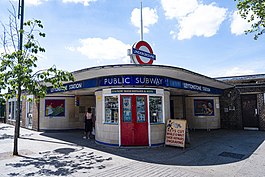
The Central line is a London Underground line that runs through central London, from Epping, Essex, in the north-east to Ealing Broadway and West Ruislip in west London. Printed in red on the Tube map, the line serves 49 stations over 46 miles (74 km), making it the longest line on the Underground. It is one of only two lines on the Underground network to cross the Greater London boundary, the other being the Metropolitan line. One of London's deep-level railways, Central line trains are smaller than those on British main lines.

Roding Valley is a London Underground station situated in Buckhurst Hill in the Epping Forest district of Essex, straddling the boundary between that council and Greater London. The station is on the Hainault loop of the Central line between Chigwell and Woodford stations. However, geographically it is midway between Woodford and Buckhurst Hill stations. It is located between Station Way and Cherry Tree Rise. Since 2 January 2007, the station has been in Travelcard Zone 4.

Leytonstone is an area in East London, England, within the London Borough of Waltham Forest. It adjoins Wanstead to the north-east, Forest Gate to the south-east, Stratford to the south-west, Leyton to the west, and Walthamstow to the north-west, and is 7 miles (11 km) north-east of Charing Cross.

Leyton is a London Underground station in Leyton, in the London Borough of Waltham Forest, East London. Located on Leyton High Road, adjacent to the A12, the station is on the Central line between Stratford and Leytonstone stations. It is in Travelcard zone 3.
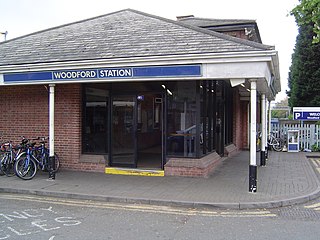
Woodford is a London Underground station in the town of Woodford in the London Borough of Redbridge, East London. The station is on the Central line, between South Woodford and Buckhurst Hill stations and is in Travelcard Zone 4. The station also acts as a terminus for services via the Hainault loop.

Loughton is a London Underground station in the Epping Forest district of Essex. It is entirely above ground, and platforms are accessed by staircases which rise from ground level.

Buckhurst Hill is a London Underground station, in the Epping Forest district of Essex. It is served by the Central line and is between Woodford and Loughton. It is the larger of the two Underground stations in the town of Buckhurst Hill, with Roding Valley station being the smaller. It is the only London Underground station located in Zone 5 but not in a London Borough.

Grange Hill is a London Underground station on the Central line which lies in the parish of Chigwell in the Epping Forest district of Essex. The boundary with the London Borough of Redbridge is immediately to the east of the station buildings. The station is between Hainault and Chigwell stations. The station has been in Travelcard Zone 4 since 2 January 2007.
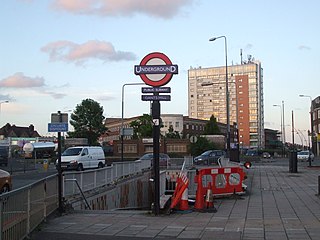
Gants Hill is a London Underground station in the largely residential Gants Hill district of Ilford in East London. It is served by the Central line and is between Redbridge and Newbury Park stations on the Hainault loop. It is in Travelcard Zone 4. It is the easternmost station to be below ground on the London Underground network and the busiest on the Hainault loop.
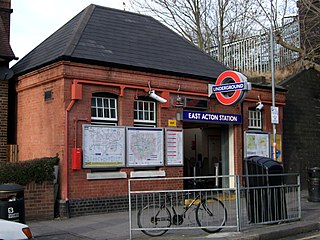
East Acton is a London Underground station in East Acton in London Borough of Hammersmith and Fulham. The station is on the Central line, between White City and North Acton stations, and in Travelcard Zone 2. Wormwood Scrubs, Queen Charlotte's and Chelsea Hospital, Hammersmith Hospital, Wormwood Scrubs prison and Imperial College Hammersmith branch are accessible from the station.

Wanstead is a London Underground station in Wanstead in the London Borough of Redbridge, east London. on the Hainault loop of the Central line. Towards Central London the next station is Leytonstone. Towards Woodford it is Redbridge. It is in Travelcard Zone 4. It opened on 14 December 1947 as an extension of the Central line to form the new part of the Hainault loop.

South Woodford, originally George Lane, is a London Underground station in the suburb of South Woodford in East London. It is on the Epping branch of the Central line, between Snaresbrook and Woodford stations and is in Travelcard Zone 4.

Theydon Bois is a London Underground station in the village of Theydon Bois in Essex, England. It is served by the Central line and is between Debden and Epping, in Travelcard Zone 6.
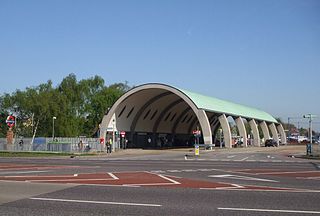
Newbury Park is a London Underground station in Newbury Park, Ilford, East London. It is between Barkingside and Gants Hill stations on the Hainault loop of the Central line, in Travelcard Zone 4. The station was initially opened by the Great Eastern Railway on 1 May 1903 and subsequently transferred its services to the London & North Eastern Railway due to the amalgamation. Underground trains only started serving the station on 14 December 1947, operating via the Gants Hill tunnel. The line was extended to Hainault on 31 May 1948. The Grade II listed bus shelter designed by Oliver Hill opened on 6 July 1949. Lifts were fully installed at Newbury Park in November 2018 to provide step-free access to the station, approximately 10 years after TfL abandoned the project.

Redbridge is a London Underground station on Eastern Avenue in the Redbridge district of Ilford in North East London, on the Hainault Loop of the Central line, in Zone 4. It opened on 14 December 1947 as an extension of the Central line to form the new part of the Hainault loop.

Barkingside is a London Underground station on the Central line. It is on the eastern edge of Barkingside in east London at the end of a cul-de-sac off Station Road. The station is next door to the home of Redbridge F.C. It is between Newbury Park and Fairlop stations and has been in Travelcard Zone 4 since 2 January 2007.

Fairlop is a London Underground station in Fairlop in east London, England, which is on the Central line of the London Underground. It has been in Travelcard Zone 4 since 2 January 2007. It is on the north side of Forest Road, in Fairlop, just north of Barkingside.

Hainault is a London Underground station in Hainault, east London, England. The station is on the Central line between Fairlop and Grange Hill stations. Since 2 January 2007, the station has been in Travelcard Zone 4. It is also home to one of the three Central line depots.

Chigwell is a London Underground station in the town of Chigwell in the Epping Forest district of Essex. It is located on the Hainault Loop of the Central line, between Grange Hill and Roding Valley stations.
The Hainault Loop, originally opened as the Fairlop Loop, is a 6.5-mile (10.5 km) branch line of the Great Eastern Railway (GER). It once connected Woodford on the Ongar branch to Ilford on the Main Line, with an eastward connection for goods, excursions and stock transfers to Seven Kings. The loop opened to freight on 20 April 1903 and to passengers on 1 May 1903. In 1923, the GER was "grouped" into the London & North Eastern Railway (LNER), who provided passenger services until December 1947. After this date, the route was electrified for London Underground services from both the Woodford and Leytonstone directions, the link to Ilford closed, and today it forms the greater part of the Hainault Loop on the Central line, having been served by Tube trains since 1948.
